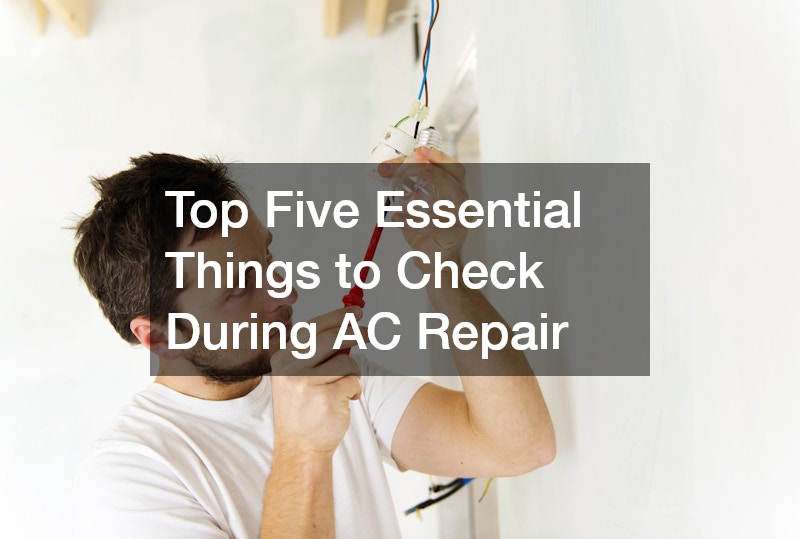With rising temperatures each year, the air conditioner has become one of the most indispensable appliances in our homes and offices. Like any other appliance, however, AC units can run into issues and require maintenance or repair. It’s essential to address these issues promptly to ensure your system functions efficiently during the sweltering summer months. Knowing what to look out for during an AC repair can make a significant difference in identifying both minor and major problems. Here, we present the top five essential things to check during AC repair, helping you stay ahead of any potential issues.
1. Check the Air Filter
The air filter is one of the most vital components of an AC system and often the root of several issues. A clogged or dirty air filter can restrict airflow, thus reducing the system’s efficiency and, in severe cases, causing the AC to freeze up. It’s important to regularly inspect and replace the air filter if necessary—ideally every month during peak usage seasons. Clean air filters not only improve air quality but also prevent your system from overworking, which can greatly reduce energy consumption. Ensuring the air filter is in good condition is a simple yet effective step in any AC repair process.
2. Inspect the Thermostat
Your AC system relies on the thermostat to regulate temperature. If your AC unit is not cooling properly, the thermostat might be to blame. First, make sure that the thermostat is set to the correct temperature. If your thermostat is battery-operated, check if the batteries need replacement. If you’ve noticed discrepancies in your energy bills, malfunctioning thermostats could be the culprit. Testing your thermostat ensures your AC performs as intended, providing the comfort you seek during the hottest days of the year.
3. Examine Electrical Components
Electrical components within your air conditioning unit are crucial for its operation. Loose or frayed wiring can lead to inefficient functioning or, worse, pose a fire hazard. During a repair check, it is important to ensure all electrical connections are secure and show no sign of wear and tear. Additionally, check the circuit breakers or fuses. It’s worth noting that some common AC problems are often electrical in nature, making this step essential in any comprehensive repair routine. Staying vigilant with your system’s electrical components can prevent significant damage and extend the longevity of your unit.
4. Assess Refrigerant Levels
Another key aspect during AC repair is checking the refrigerant levels. Low refrigerant levels usually indicate a leak, which can seriously impair the cooling ability of your unit. Identifying and addressing this issue promptly is vital to prevent further damage to your AC. A system low on refrigerant won’t cool efficiently and could overheat, leading to more extensive and costly repairs. To maintain optimal performance, it’s critical that a qualified technician measure and, if needed, refill the refrigerant to the required levels.
5. Inspect the Condenser Coils
The condenser coils play a significant role in the air conditioning process by releasing the heat absorbed from inside the house to the outside. If these coils become dirty or blocked, they can hinder the heat exchange process and reduce the system’s efficiency. During an AC repair check, it’s important to clean the condenser coils and remove any debris. This maintenance task can enhance the cooling efficiency and prevent the unit from overheating. Always ensure that there is plenty of clearance around your outdoor unit to allow proper airflow and avoid any potential hindrance to the coils’ functionality.
Regular maintenance and repair are crucial to keeping your AC system running efficiently and prolonging its life. By checking these five essential components—air filter, thermostat, electrical components, refrigerant levels, and condenser coils—you can identify and resolve minor issues before they escalate into costly repairs. Keeping your air conditioning system well-maintained not only ensures comfort but also optimizes energy usage, saving you money in the long run. Proper maintenance reduces the strain on your system, helping it run more efficiently and preventing it from overworking, which can lead to breakdowns. Furthermore, a well-maintained AC system promotes better air quality by ensuring that air filters are clean and that there are no blockages in the system. This leads to a healthier environment for you and your family. With these inspection steps in mind, you can stay cool and comfortable even during the hottest months. Don’t wait for a complete breakdown to inspect these elements; being proactive with your AC maintenance is key. Regular check-ups will not only enhance your comfort but also extend the lifespan of your unit, ultimately offering you peace of mind year after year.
.




